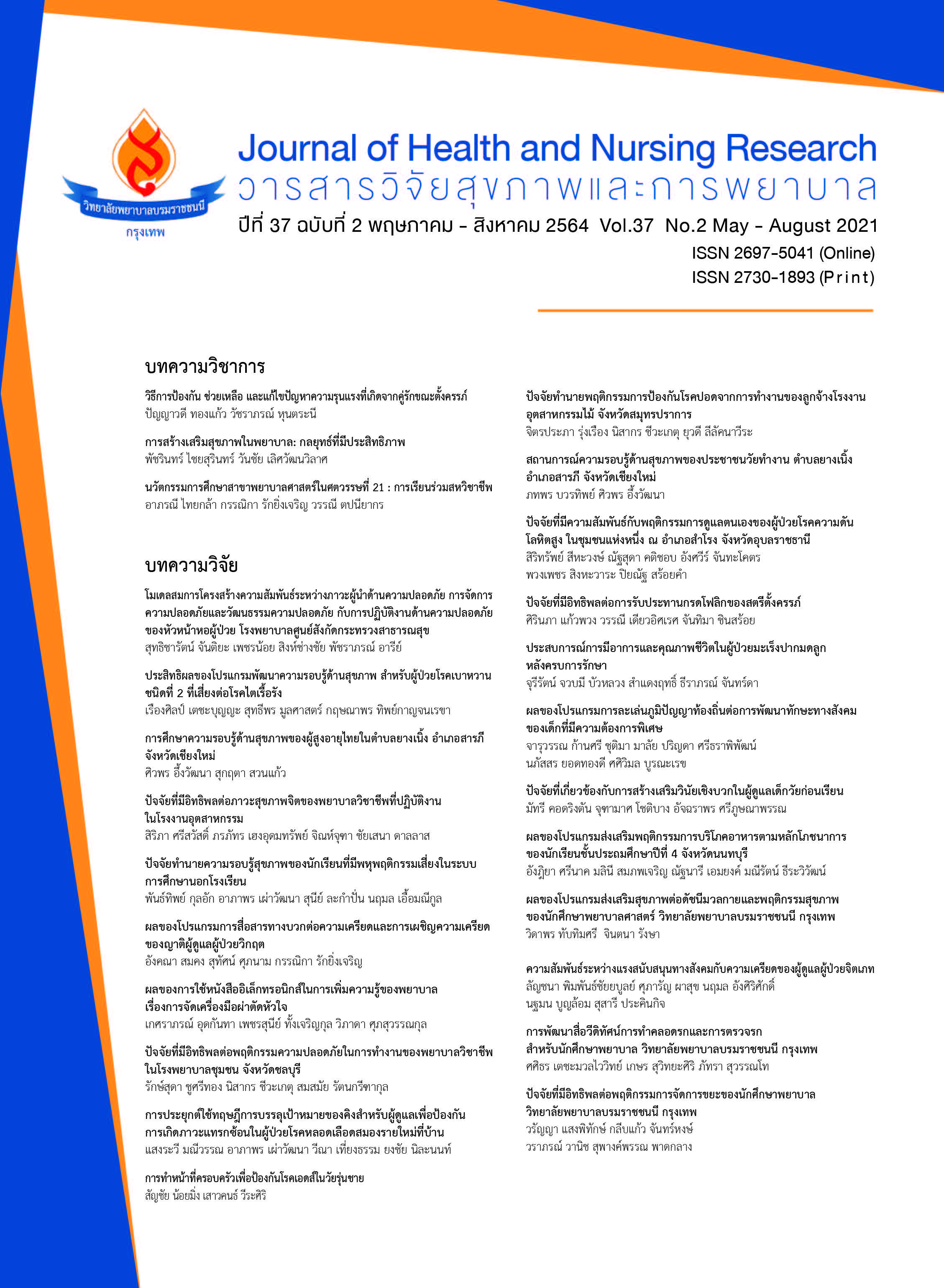ปัจจัยทำนายความรอบรู้สุขภาพของนักเรียนที่มีพหุพฤติกรรมเสี่ยง ในระบบการศึกษานอกโรงเรียน
บทคัดย่อ
บทนำ: การศึกษาครั้งนี้ใช้แบบจำลองทางนิเวศวิทยาเป็นกรอบแนวคิดในการศึกษา ปัจจัยที่ศึกษาประกอบด้วย ปัจจัยระดับบุคคล ปัจจัยระดับครอบครัว และปัจจัยระดับสังคม วัตถุประสงค์การวิจัย: เพื่อศึกษาปัจจัยทำนายความรอบรู้สุขภาพของนักเรียนที่มีพหุพฤติกรรมเสี่ยงในระบบการศึกษานอกโรงเรียน ระเบียบวิธีวิจัย: การวิจัยเชิงสำรวจแบบตัดขวาง กลุ่มตัวอย่างเป็นนักเรียนที่มีพหุพฤติกรรมเสี่ยง ชั้นมัธยมศึกษาตอนปลาย สังกัดศูนย์การศึกษานอกโรงเรียน เขตกรุงเทพตะวันออก จำนวน 326 คน ใช้การสุ่มตัวอย่างแบบแบ่งชั้นภูมิ (Stratified Sampling) รวบรวมข้อมูลโดยให้นักเรียนตอบแบบสอบถามด้วยตนเอง วิเคราะห์ข้อมูลด้วยสถิติพรรณนา สถิติสัมประสิทธิ์สหสัมพันธ์ของเพียร์สัน และสถิติการวิเคราะห์ถดถอยเชิงพหุคูณแบบขั้นตอน ผลการวิจัย: ปัจจัยที่มีความสัมพันธ์กับความรอบรู้สุขภาพของนักเรียนที่มีพหุพฤติกรรมเสี่ยง ได้แก่ เพศหญิง ระดับชั้นเรียน ผลการเรียนเฉลี่ย ทัศนคติต่อการหลีกเลี่ยงพหุพฤติกรรมเสี่ยง สัมพันธภาพภายในครอบครัว การควบคุมกำกับติดตามของครอบครัว การสนับสนุนจากผู้ให้บริการสุขภาพ การจัดการเรียนการสอน ผลการวิเคราะห์ถดถอยเชิงพหุคูณ พบว่า สัมพันธภาพภายในครอบครัว การสนับสนุนจากผู้ให้บริการสุขภาพ การจัดการเรียนการสอน เพศหญิง และผลการเรียนเฉลี่ย สามารถร่วมทำนายความรอบรู้สุขภาพของนักเรียนที่มีพหุพฤติกรรมเสี่ยงได้ร้อยละ 27.8 (R2 = 0.278, p<.05) สรุปผล: การที่จะสนับสนุนและส่งเสริมการพัฒนาความรอบรู้สุขภาพของนักเรียนที่มีพหุพฤติกรรมเสี่ยงนั้น ประกอบไปด้วย ปัจจัยระดับบุคคล ปัจจัยระดับครอบครัว และปัจจัยระดับสังคม ซึ่งผลจากการศึกษาครั้งนี้ก็เป็นไปตามกรอบแนวคิดของแบบจำลองทางนิเวศวิทยา ข้อเสนอแนะ: ผลการวิจัยนี้สามารถนำไปเป็นข้อมูลพื้นฐานในการสร้างโปรแกรมพัฒนาความรอบรู้สุขภาพของนักเรียนที่มีพหุพฤติกรรมเสี่ยง โดยบุคลากรด้านสาธารณสุขประสานงานกับระบบการศึกษานอกโรงเรียนเพื่อร่วมกันส่งเสริมการให้ความรู้ การเข้าถึงข้อมูลสุขภาพ และปรับทัศนคติต่อการหลีกเลี่ยงพหุพฤติกรรมเสี่ยง เน้นให้ครอบครัวมีส่วนร่วมและส่งเสริมการสร้างสัมพันธภาพที่ดีภายในครอบครัว
Downloads
เอกสารอ้างอิง
Nutbeam D. Health literacy as a public health goal: a challenge for contemporary health education and communication strategies into the 21st century. Journal of Health Promotion International 2000;15(3):259-67.
Tachawitchitjaru C. Health literacy: a key Indicator towards good health behavior. Journal of The Royal Thai Army Nurses 2017;19(1):1-11. (in Thai).
Intarakamhang U. Health literacy: measurement and development. Bangkok: Sukhumvit Printing Company Limited; 2017. (in Thai).
Department of Health. Guidelines for the development of friendly health services for teens and youth. Bangkok: The agricultural co-operation federation of Thailand; 2016. (in Thai).
Kipping RR, Campbell RM, MacArthur GJ, Gunnell DJ, Hickman M. Multiple risk behaviors in adolescence. Journal of Public Health (2012);34(1):i1-i2.
Richter M. Risk behaviors in adolescence. Germany: Springer; 2010.
Neal LB. Neurobiology of nicotine addiction: implications for smoking cessation treatment. American Journal of Medicine 2008;121(4):3-10.
Thammarangsi T. Academic documents, alcohol and brain set. [Internet]. 2018. [cited 2019 Oct1].Available from: http://resource.thaihealth.or.th/system/files/documents/11.eksaarwichaakaarchud_aelkhlaelasmng.pdf. (in Thai)
Mwangi M, Waruru A, Waruiru W, Gichangi A, Toroitich RC, Kim AA. Factors associated with unsafe sex among Kenyan youth. East African journal of applied health monitoring and evaluation 2018;2(1):25-37.
Thammaraksa P, Powwattana A, Wannasuntad S, Tipkanjanaraykha K. Factors related to multiple risk behaviors among female secondary school students. Journal of Health and Nursing Research 2019;35(1):224 - 38. (in Thai).
Thaikla K. A set of facts about youth outside the school. [Internet]. 2016. [cited 2019 Oct 1]. Available from: http://medipe2.psu.ac.th/tsaan/content_info.php. (in Thai).
Department of Disease Control. Report of 5 situations of sexually transmitted diseases in youth.
[Internet]. 2018. [cited 2019 Oct 1]. Available from: https://ddc.moph.go.th/uploads/publish/100602020050705 840.pdf. (in Thai).
Office of Learning Center. School of Health: Educational Innovation (Healthy school). [Internet].2017. [cited 2020 June 3]. Available from: http://resource.thaihealth.or.th/library/ hot. (in Thai).
Manganello JA. Health literacy and adolescents: a framework and agenda for future research. Health Education Research 2008; 23(5):840-47.
Panahi R, Ramezankhani A, Tavousi M, Koosehloo A, Niknami S. Relationship of health literacy with knowledge and attitude toward the harms of cigarette smoking among university students. Hamedan University of Medical Sciences 2017;3(4):38-44.
Thongnopakun S, Pumpaibool T, Somrongthong R. The association of sociodemographic characteristics and sexual risk behaviors with health literacy toward behaviors for preventing unintended pregnancy among university students. Journal of multidisciplinary healthcare 2018;11:149-56. (in Thai).
Khotnala F, Vonok L, Wawngam W, Kansin S, Suwannaphant K. Health literacy and alcohol consumption in senior secondary school students, Chaiyaphum province. Journal of Health Science and Community Public Health 2017;1(2):147 - 63. (in Thai).
Bronfenbrenner U. The ecology of human development: Harvard university press; 1979.
Ye XH, Yang Y, Gao YH, Chen, SD, Xu Y. Status and determinants of health literacy among adolescents in Guangdong China. Asian Pacific Journal of Cancer Prevention 2014;15(20):8735-40.
Arain M, Haque M, Johal L, Mathur P, Nel W, Rais A, et al. Maturation of the adolescent brain. Neuropsychia tric Disease and Treatment 2013;9:449-61.
Ghaddar SF, Valerio MA, Garcia CM, Hansen L. Adolescent health literacy: The importance of credible sources for online health information. Journal of School Health 2012;82(1):28-36.
Ngomsangad Y, Srisuriyawet R, Homsin P. Factors influencing health literacy related pregnancy prevention among female adolescent students in Si Sa Ket province. The Public Health Journal of Burapha University 2019;14(2):37 - 51. (in Thai).
Ran M, Peng L, Liu Q, Pender M, He F, Wang H. The association between quality of life and health literacy among junior middle school students. BMC public health (2018); 18(1):1183. doi: 10.1186/s12889-018-6082-5.
Daniel WW. Biostatistics: a foundation for analysis in the health sciences. USA: Edward Brother Malloy; 1995.
Duangkaew K, Powwattana A, Auemaneekul A. Factors related to multiple risk behaviors among vocational students in Bangkok. Journal of Public Health Nursing 2017;31(Special Edition):75 -96. (in Thai).
Wutisawat S. A study of relationship between students in level 2 [Master’s thesis]. Bangkok:Srinakharinwirot University; 2009. (in Thai).
Bucharoen W, Powwattana A, Pichayapinyo P. Factors related to sexual risk behaviors among secondary school students. Journal of Public Health 2013; 42(1): 30-40. (in Thai).
Department of Mental Health. Friendly health service standards for teens and youth Integrated version. Bangkok: Kaew Chao Chom Publications Center; 2014. (in Thai).
Roma W, Thanasukan C, Thipmongkolkun M, Emyong N, SamnuanKlang M, Khoiiam S. National health literacy survey project for Thai people aged 15 years and above (phase 1). Health Systems Research Institute (HSRI) 2017:1-115. (in Thai).
Intarakamhang U, Khumthong T. Measurement development assessment of health literacy and unwanted pregnancy prevention behavior for Thai female adolescents. Journal of Public HealthNursing 2017:31(3):19-38. (in Thai).
Tyan YS, Liao JR, Shen CY, Lin YC, Weng JC. Gender differences in the structural connectome of the teenage brain revealed by generalized q-sampling MRI. Journal of NeuroImage Clinical 2017;15(1):376-82.
Ajzen I. The personal and behavior (2nded). New York: two penn plaza; 2005.
Powwattana A, Auemaneekul N, Lagampan N. Prevention of risk behavior in adolescents, concepts and management at multiple levels. Bangkok: Danex; 2017. (in Thai).
ดาวน์โหลด
เผยแพร่แล้ว
รูปแบบการอ้างอิง
ฉบับ
ประเภทบทความ
สัญญาอนุญาต
บทความที่ได้รับการตีพิมพ์ เป็นลิขสิทธิ์ของวารสารวิจัยสุขภาพและการพยาบาล (วิทยาลัยพยาบาลบรมราชชนนี กรุงเทพ) ไม่สามารถนำไปตีพิมพ์ซ้ำในวารสารฉบับอื่น


















